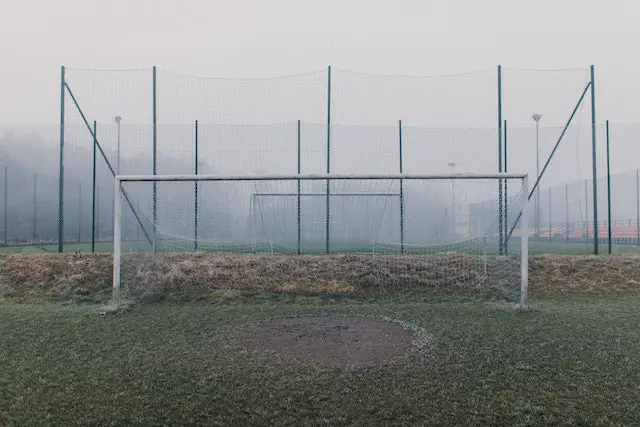Soccer nets are big to make it challenging for the goalkeeper to save the shots and also to make scoring goals more challenging. This size has evolved over time and is regulated by FIFA to maintain consistency in international matches.
The dimensions of the goal frame also allow for fair play, preventing controversies about whether a shot was a goal or not.
In this article, we will delve into the reasons behind the size of soccer nets, its historical evolution, and its influence on scoring, goalkeepers, and the overall strategy of the game.
Key Takeaways:
- Soccer nets are large to add excitement and challenge to the game.
- FIFA regulations standardize net size for consistency.
- Goalkeepers face challenges with larger nets, requiring adaptability.
- Larger nets offer advantages to attackers but raise performance expectations.
The Evolution of Soccer Nets
Embed from Getty ImagesThe historical development of soccer nets dates back centuries. In early forms of the game, there were no nets; instead, players aimed to get the ball between two designated points, like trees or rocks, to score.
Embed from Getty ImagesAs the sport evolved, rudimentary netting systems were introduced to make it easier to identify goals. These early nets were often irregular in size and shape, leading to inconsistencies in scoring.
In the late 19th century, with the formalization of soccer rules, standardization of goalposts and nets began. The dimensions of soccer nets were established to ensure fairness and uniformity in matches. This standardization helped prevent disputes over whether a goal had been scored.
Over time, advancements in materials and technology improved the durability and visibility of soccer nets. Today, FIFA and other governing bodies have specific regulations in place to maintain the size and quality of nets used in professional soccer matches. This historical progression has contributed to the modern soccer net design we see today.
FIFA Regulations and Standardization
FIFA, the international governing body for soccer, has precise regulations regarding soccer net size to maintain consistency in the game.
FIFA’s regulations specify that soccer nets must have the following dimensions:
- The width of the goal must be 7.32 meters (approximately 24 feet).
- The height of the goal must be 2.44 meters (approximately 8 feet).

These regulations ensure that soccer nets used in FIFA-sanctioned matches, including the World Cup, adhere to a standard size. This standardization helps ensure fairness and accuracy in determining when a goal has been scored.
What Size is Women’s Soccer Nets?
Embed from Getty ImagesA women’s soccer net is the same size as a men’s soccer net. It has a width of 7.32 meters (approximately 24 feet) and a height of 2.44 meters (approximately 8 feet). The dimensions for the soccer nets are uniform across all official matches, irrespective of gender.
Size of the Net From Goalkeeper’s Perspective
Embed from Getty ImagesLarge soccer nets pose challenges for goalkeepers in terms of coverage, agility, and psychological factors. Goalkeepers must constantly adapt their skills and strategies to effectively defend against a wider target.
- Increased Scoring Opportunities: Larger nets provide more space for the opposing team to aim at, making it harder for goalkeepers to cover all angles.
- Quick Reflexes: Goalkeepers must possess lightning-fast reflexes to react to shots aimed at the vast expanse of the goal, requiring split-second decision-making.
- Diving Distances: The extended width of the net requires goalkeepers to cover a broader area when diving to make saves, demanding exceptional agility.
- One-on-One Situations: In one-on-one situations, goalkeepers face a greater challenge when the shooter has a wider target to aim for.
- High Shots: Larger nets can lead to an increase in high shots, making it difficult for goalkeepers to leap and reach balls aimed at the top corners.
- Psychological Pressure: The perception of a larger goal can create psychological pressure on goalkeepers, affecting their confidence.
- Strategic Positioning: Goalkeepers must continually adjust their positioning to effectively guard the goal, as attackers have more options for shot placement.
- Anticipation: Anticipating the trajectory of shots becomes more complex due to the increased variability in shot placement.
How the Size of the Goal Impacts Scoring Strategies
Embed from Getty ImagesWhen nets are larger, it creates more space for attackers to aim at, increasing the opportunities for scoring goals. This encourages teams to adopt a more aggressive offensive approach. Players may attempt long-distance shots and shots aimed at the corners, as there is a greater chance of success with a larger target.
Advantages for the Attacking Team
- Increased Scoring Opportunities: Larger nets provide attackers with a bigger target to aim for, increasing the likelihood of scoring goals. This encourages a more offensive mindset.
- Room for Creativity: Attackers have more space to execute creative plays, such as long-range shots, precise crosses, and intricate passing combinations.
- Higher Scoring Matches: Matches with larger nets tend to have more goals, which can be advantageous for attacking teams seeking to secure victories.
Disadvantages for the Attacking Team
- Expectation to Perform: With more scoring opportunities, attacking teams face higher expectations to produce goals consistently. There’s added pressure to deliver in front of the goal.
- Transition Vulnerability: Focusing on offense can sometimes leave a team vulnerable to counterattacks, as players commit forward, leaving spaces behind that opponents can exploit.
Conclusion: Why Are Soccer Nets So Big?
In conclusion, soccer nets are made large to make the matches more challenging and exciting for players and fans alike. Their size has evolved over time and is regulated by FIFA to ensure fairness in the game.
If you enjoyed this article, I would really appreciate if you could share it with fellow soccer enthusiasts. Your support and sharing of this content can help us reach a wider audience and provide valuable information to more people who share our passion for the beautiful game.
Thank you for you continued support!











